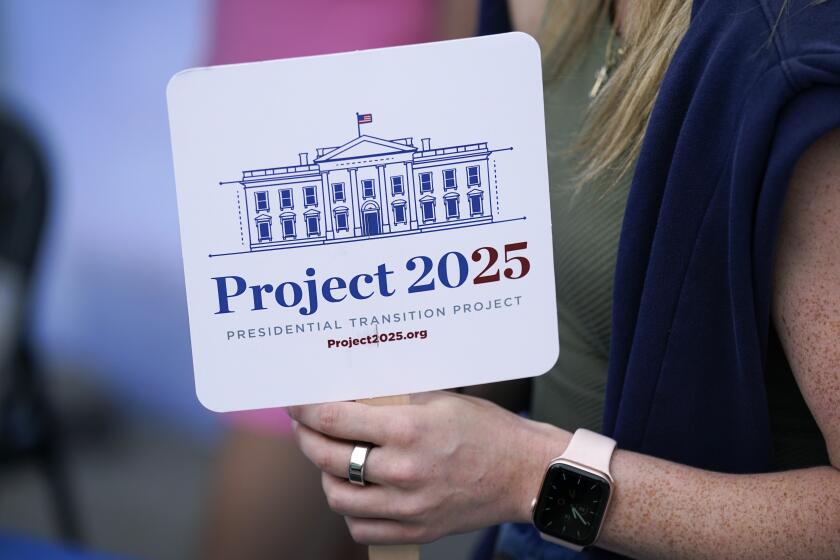Supreme Court to decide whether U.S. Border Patrol agent can be sued for shooting Mexican teenager
- Share via
Reporting from WASHINGTON — The Supreme Court agreed Tuesday to decide whether a U.S. Border Patrol agent can be sued for shooting and killing a Mexican teenager who was playing with friends in the concrete culvert that separates El Paso, Texas, from Juarez, Mexico.
The shooting of an unarmed 15-year-old named Sergio Hernandez provoked outrage in Mexico in 2010 and set off a prolonged legal dispute over the reach of the U.S. Constitution.
At issue is whether the 4th’s Amendment’s ban on unreasonable seizures and the unjustified use of deadly force stops at the U.S. border or extends to border areas patrolled by U.S. agents.
Critics long have accused the Border Patrol of using lethal force with impunity, and the court could impose limits on the alleged abuses for the first time.
The appeal to the Supreme Court cited a Los Angeles Times story last year on how the Border Patrol had absolved itself and its agents in dozens of cases of lethal force.
In cases involving Guantanamo Bay prisoners, the justices ruled that the Constitution’s protection for habeas corpus extended to alleged foreign terrorists who were held at the U.S. Naval Station in Cuba.
Lawyers for the parents of the slain Mexican teenager argue that the Constitution’s protections against excessive force should extend to the border area where U.S. agents patrol.
Hernandez “was killed in a culvert the U.S. officials patrol and effectively control,” they wrote in their appeal to the high court.
Last year, the 5th Circuit Court of Appeals tossed out the parents’ suit against Border Patrol agent Jesus Mesa Jr. on the grounds that Hernandez was a Mexican citizen “who was on Mexican soil at the time he was shot.”
The Supreme Court weighed whether to take the case for nearly a year.
Last spring, the Justice Department urged the court to deny the appeal and argued that Mesa, the Border Patrol agent, was immune from being sued because he was doing his duty as a sworn law enforcement officer.
But on Tuesday the justices announced they would hear the case and issue a ruling in Hernandez vs. Mesa.
The case stems from the summer of 2010, when Hernandez and three friends “were playing a game in which they dared each other to run up the culvert’s northern incline, touch the U.S. fence and then scamper back down to the bottom,” the parent’s lawyers said in their appeal.
The boys were not trying to sneak into the U.S. and they chose a spot “in plain view” near a busy border crossing, they said.
But when Agent Mesa arrived on a bicycle, the boys ran. He drew his weapon and shot the 15-year-old in the head. They were only 60 feet apart, but Mesa was on the U.S. side of the border and the dead teenager was on the Mexican side.
The next day, the FBI released a statement saying Mesa had acted in self-defense after the boys “began to throw rocks” at him. But cellphone videos of the incident showed the boys were not throwing rocks.
The Justice Department looked into the matter but closed its investigation a year later without taking action.
Steve Shadowen, a lawyer representing the Hernandez family, said the case represents “a very fundamental principle of international human rights law and of our national law. And that is, the executive branch cannot take innocent civilian life without judicial review. That’s the very meaning of the rule of law.”
Separately, the court said it would hear the government’s bid to halt a long-running lawsuit against former U.S. Atty. Gen. John Ashcroft and other top officials from the George W. Bush administration over the detentions of several Muslim men after the Sept. 11, 2001, attacks.
The Justice Department says these officials are immune from such claims, but a divided U.S. appeals court in New York said the suit may proceed.
Only six justices will hear the case. Justices Sonia Sotomayor and Elena Kagan said they had withdrawn, apparently because they were involved with some aspect of this case in the past.
The court’s ninth seat has been empty since the death of Justice Antonin Scalia in February.
Times staff writer Joseph Tanfani contributed to this report.
On Twitter: DavidGSavage
ALSO
Should it be legal to have a congressional district only one party can win?
Court disputes over voting laws often divide justices along party lines
Supreme Court justices question big verdict against Samsung for copying Apple’s iPhone
More to Read
Sign up for Essential California
The most important California stories and recommendations in your inbox every morning.
You may occasionally receive promotional content from the Los Angeles Times.











